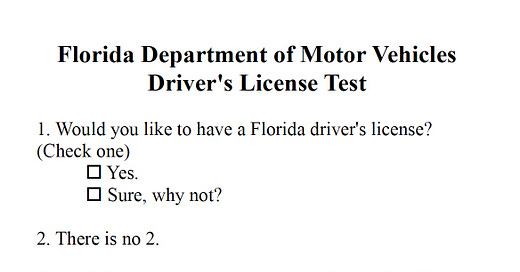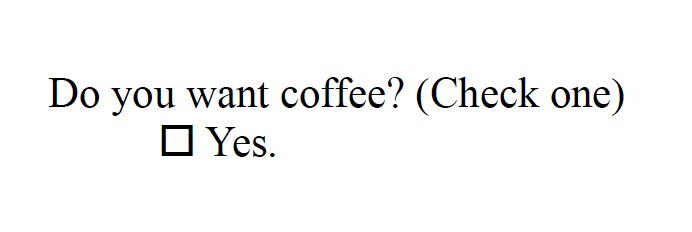The other day I was driving on the Florida Turnpike during the morning rush hour when I decided to stop for coffee so I could stay alert and, ideally, not get killed.
This is always a distinct possibility on the Florida Turnpike, which, because of a tragic design flaw, is located in Florida. As a result, many of the people driving on it are Florida residents, who, as a group, are the worst drivers in the world, including members of primitive Amazonian rainforest tribes who have never seen an automobile.
Florida will issue a driver's license to pretty much anybody. Perhaps you think I'm exaggerating. Perhaps you will change your mind when you see this actual facsimile of the official written test that applicants must take to get a Florida license:
Now you're thinking: "But surely applicants must take a road test, to prove that they're competent drivers." Don’t be an idiot. The Florida DMV eliminated road tests years ago because so few test administrators returned alive.
So driving in Florida is a sketchy enterprise. It's especially sketchy in the Miami area, where I live. For many years I've said that all of the drivers in Miami obey the traffic laws... of their individual countries of origin. When I say this, people who don't live in Miami chuckle, because they think I'm joking. People who live here do not chuckle.
Apparently there are countries where it's customary to maintain a speed of 23 miles per hour in left lane of an expressway, and it's OK to back up if you miss your exit, but it is strictly forbidden — for any reason, under any circumstances whatsoever — to yield to another motorist, or God forbid activate a turn signal. Also in these countries the traditional way to navigate a traffic circle is to enter the circle without looking, then come to an abrupt stop so as to take stock of the situation. These are just some of the customs strictly observed on the roads of South Florida. You don't even want to know what happens at a four-way stop.
But getting back to my point (yes, I have a point): I was driving on the Florida Turnpike, and since I was in the greater Miami area I wanted to be extra alert, so I pulled into a service plaza to get a cup of coffee from the Dunkin' Donuts. As I approached the counter I could see that there were three employees working there, and only one couple ahead of me, so I assumed I'd have my coffee in a minute or so and be on my way.
I was a fool.
It turned out that this particular Dunkin' Donuts uses a "kiosk" ordering system. The word "kiosk" comes from the Turkish words "ki," meaning "computer screen," and "osk," meaning "which you must use to place your order but some people have a lot of trouble understanding how it works and these people are always in front of you."
There was only one kiosk at the Dunkin' Donuts, so I couldn't order my coffee until the couple ahead of me — let's call them the Dundersons — finished entering their order. As far as I could tell, they were trying to order a latte and an iced coffee. Also they wanted extra sugars. (It would be snide of me to point out that the Dundersons definitely did not need extra sugars, so I will take the high road here and put this fact in parentheses.)
It seemed to me, peering over their shoulders, that the kiosk touchscreen was fairly straightforward. Here's what it looked like:
But the Dundersons found the kiosk to be baffling. To them, apparently, it looked like this:
I will try not to exaggerate here: I stood behind the Dundersons for at least ten minutes, with a growing line of people behind me, all of us watching the Dundersons tapping away at the kiosk, scrolling through screen after screen, pausing often to discuss the situation, tapping and scrolling and discussing, tapping and scrolling and discussing, returning to the same screens over and over and over and OVER without reaching the point where they felt confident enough to pull the trigger on their order of two coffees with extra sugars, let alone figure out how to pay.
Meanwhile, on the other side of the counter, just a few feet away, the three Dunkin' Donuts employees were standing around, waiting for something to do. In the olden days, I could have just leaned around the Dundersons and said "I'd like a large black coffee please." But in the modern digital era there is no room for that kind of hopelessly inefficient analog human interaction. In the modern digital era your order must be entered on the kiosk screen so it can be transmitted at the speed of light via satellite across thousands of miles of space to the Dunkin' Donuts central computer in Massachusetts or possibly Taiwan, which then transmits it via satellite across thousands of miles of space at the speed of light to the screen in front of the employees standing on the other side of the counter. This sounds complicated, but thanks to the miracle of technology it happens in less time than it takes you to fart.
After what felt like forever, the Dundersons finally managed to execute their order. I wanted to cheer. The last time I was that excited about a human technological achievement was when I watched the first Moon landing. I then stepped up to the kiosk and, feeling the pressure of the line behind me, ordered a large black coffee, which I was able to do — bear in mind that I'm fairly "tech-savvy" for a person of my age (153 years old) — in around three minutes, after which I received my coffee and was able to resume risking death on the turnpike. The whole process took maybe 15 minutes, or roughly 14 minutes longer than if the Dunkin’ employees and I had been permitted to engage in direct inefficient human contact.
My point is, I'm not a fan of the kiosk system. I understand that, for economic reasons, kiosks are here to stay; I also understand that some people – especially younger people, who use "apps" for everything including brushing their teeth – would rather use kiosks than interact with other humans.
But if we have to have kiosks, I think we could make some improvements. For example, there should always be more than one kiosk, and there should be express kiosks for people who have simple orders, with streamlined software modeled on the Florida driver’s-license test:
Also I think kiosks should have some kind of enforcement mechanism to speed up the ordering process. If a person is ordering from a kiosk, and that person keeps returning to the same screen over and over, at some point — let’s say the fourth time — the kiosk will administer an electrical shock proportional to the number of people waiting in line behind that person. Granted, if there had been such a mechanism in place at the turnpike Dunkin’Donuts where I got my coffee, Dundersons would have been reduced to smoking lumps of carbon. But that is the price we pay for progress.
And now let’s find out what you paid subscribers think (I love you, paid subscribers) via a scientific poll:








I went into a Dunkin recently, walked up to the counter and place my order. It took me a moment to realize why the employee looked like a deer caught in headlights: I had skipped the kiosk, made direct human contact, and the employee wasn't sure how to handle this. In my defense, I didn't see the machine because I hadn't had my coffee yet.
What a thrill it would be to get in line at a turnpike Dunkin Donuts and to see Dave Barry there. "Excuse me," I'd say, "Aren't you--" and you'd say, "Yes, that's me, award winning writer and Floridian Dave Barry."
"Right, but aren't you aware there's a line?"
Anyway my point is I've really missed you and an so glad you're here. Just please stop cutting in line.